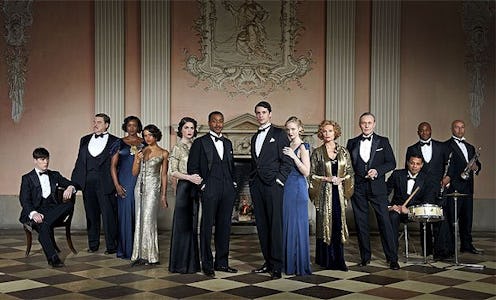Entertainment
'Dancing on the Edge' is Great Television

Come along, old sport, and see the latest hotshot on the block: Starz's smoky, jazzed-up murder-mystery miniseries, Dancing on the Edge — a show that's seriously worth trumpeting about [insert sad trombone sound here]. Not just because it stars the brilliant Chiwetel Ejiofor, Matthew Goode, and John Goodman. Or because it features the latest Doctor Who companion Jenna Coleman. And though the music and lush visuals certainly don't hurt matters, it's all about what's at the heart of the story: the black experience in the getting-there-but-not-quite-progressed world of 1930s London. It's a fascinating, well-produced story.
The Louis Lester Band's music of choice — jazz, natch — fuels the languid storytelling underfoot. Jazz was a bit of a social lubricant for white aristocracy during the time. It was an escape, and (probably) a bit of a guilty pleasure for those who fell into its clutches. Filled with sexuality and thrill, the people the band played for would use said music as an excuse (or scapegoat) for bad behaviors and laissez-faire doings. Its role is dual: both backdrop and a centerpiece to the main players' cavalier doings — something to take you away, but easy to blame when the tough gets going. And, well, you don't have to look too deep to see the connection between how society folk treated both the music and its musicians.
The performances are as interesting as the complexities of its characters: Ejiofor shines as Louis Lester, a band leader with vision, drive, and immense talents. Julian (played by Tom Hughes) unnerves from second one, as do most of the unfathomable antics of these other Other Halfers, including his sister Pamela (Joanna Vanderham), her friend/stylist/photographer Sarah (Janet Montgomery), and American aristocrat Masterson (John Goodman). Goode's self-serving magazine editor Stanley Mitchell is an interesting way into the series, as his intentions and motives draw skepticism from second one. A device that causes those in the audience to feel an unease about the band's trajectory, no doubt akin to what the band must've felt being thrust into such a curious world.
The most interesting facet of Dancing is its depiction of the Louis Lester Band's rise to stardom as a result of performing at said society gatherings. Hosted by London’s aristocrats (read: white people), the band becomes the player and the play thing for most of those involved. It's certainly timely considering the much-needed push for increased acceptance and empathetic understanding of the black experience.
While many a societal change was taking place in England at the time, it wasn't all easy-peasy, with the majority of the upper crust loathsome towards the mere idea of jazz, and especially when they considered the black musicians taking center stage to perform it. And while their success does come — thanks to the city’s more progressive folk — it comes at a cost.
Dancing on the Edge shows us the inherent skepticism that comes with social mobility, namely going from a "black" world to a "white" one, as well as the incredibly fragile hurdles they must face to simply have a perceived equal standing. It's damn good, and necessary viewing for folks who enjoy really good television.
You can catch Dancing on the Edge on Starz, Saturday nights at 9PM through November 23. Thank me later.